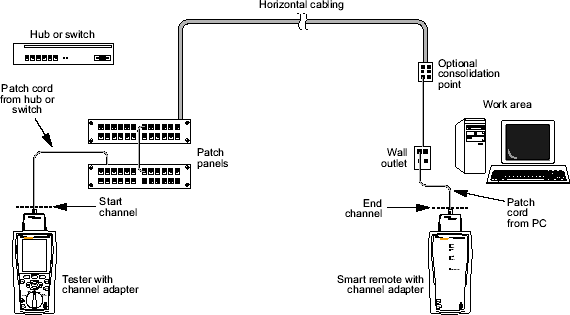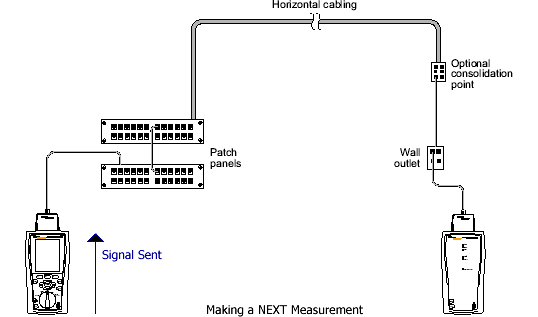Remote Connector Compensation - DTX CableAnalyzer
| With an ever-increasing number of cabling manufacturers promoting the Channel Warranty, many installers are finding themselves required to provide Channel test results. The DTX CableAnalyzer Series removes the affect of both adapters, not just the first one The Channel test configuration is only to be used by system designers and users of cabling systems to verify the performance of the overall Channel or system. The Channel can include up to 90 meters of horizontal cable, a work area equipment cord, a telecommunications outlet/connector, an optional transition connection close to the work area, and 2 cross-connect connections in the telecommunications room. The total length of equipment cords, patch cords, and jumpers shall not exceed 10 meters. Most importantly, the connections to the equipment at each end of the Channel are not included in the Channel definition:
When you make the Channel measurement, it is only valid for the patch cords used at that moment. In other words, as soon as you replace any patch cords, the recorded measurement is no longer valid. This is because no two patch cords have the same performance. For this reason, it is impossible for installers to provide Channel test results for all links. However, it is becoming common for end-users to request Channel testing for a number of installed links with different lengths of patch cords. This then gives the end-user a greater degree of confidence that the entire system meets his/her expectations and not just the installed link. System manufacturers who promote Channel Solutions also increase the desire to test the Channel. The challenge in making this measurement accurate lies with the field tester and available technology. If you refer to the diagram below, you can see that there are six connections that are sources of crosstalk (both NEXT and FEXT). What is key, is that the crosstalk generated in the connections to the field tester must not be included in the Channel measurement.
The NEXT of the mated DTX adapter connection can be effectively removed using DSP (Digital Signal Processing Techniques); we do this today in the DTX CableAnalyzers. There still remains the issue of FEXT (Far-End Crosstalk) to remove which cannot be done using DSP techniques. The DTX CableAnalyzer channel adapter is designed to have far better FEXT performance (50 dB @ 100 MHz) than required for category 6 connectors (43.1 dB @ 100 MHz) to minimize its impact. At the remote end of measurement, NEXT and FEXT properties have a similar impact on the accuracy of the channel measurement, especially on shorter links. Remote connector compensation is necessary on shorter links and at low frequencies. The standards assume that there is no impact from the crosstalk in the remote adapter, which is only true for long links and higher frequencies. That is why cabling vendors such as Systimax and Ortronics insist on using the DSP or DTX Series CableAnalyzer when making channel measurements. RC2 removes the portion of NEXT generated in the remote connection. It sounds simple but it is extremely complicated because different lengths of Channels will give different amounts of reflected crosstalk. Fluke Networks devised a mathematical algorithm for doing this. The best channel measurement accuracy is obtained using effective NEXT compensation at the local and remote adapters, and selecting a channel adapter with excellent FEXT properties; thats the DTX CableAnalyzer Series. |






